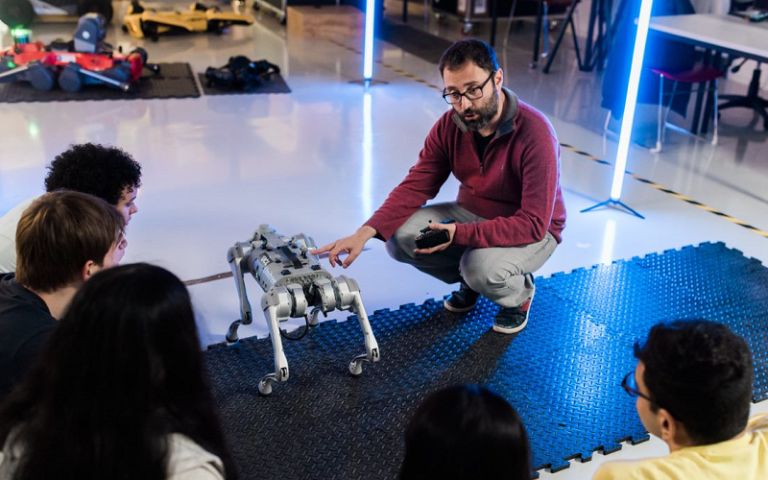UCL East: Dr Dimitrios Kanoulas, UKRI Future Leaders Fellow
A robotic revolution is happening in East London, where Dr Dimitrios Kanoulas and his team at the UCL Robotics Institute and the Department of Computer Science work at the cutting edge of innovation.

1 June 2023
From four-legged robots that can navigate disaster zones and help with agriculture, to affordable body-powered prosthetic fingertips that utilise haptic technology, the revolutionary research coming from the institute is helping to power a new wave of robotics and machine learning. And with the new campus at UCL East already turning heads in the field, the institute is set to make London a world leader in robotics.
“There’s been a barrier to what we could achieve before,” says Dimitrios. “But UCL East has changed this dramatically. We now have a fantastic space, the equipment, and, most importantly, the interdisciplinary teams we need to kickstart our vision.”
Firing up future pioneers
With state-of-the-art facilities enabling brand-new programmes in Robotics and AI, and world-leading experts on hand, UCL East is home to a new era of UCL Robotics.
Spanning One Pool Street and Marshgate, the mission for Dimitrios is to make sure that the next generation of roboticists have everything they need to shape innovation in the 21st century. “Robotics is a special case in the science world,” says Dimitrios. “Some people just need a computer or just a notepad to do their research. We need space. It’s the nature of robotics. So we couldn’t have developed much further without the facilities of UCL East.”
Part of the new vision for UCL Robotics is for students to have access to cross-sector activities and industrial collaboration to see the real-world impact of new technologies across a wide range of challenging areas – from our ageing population to secure energy and climate change.
Tapping into the creative energy from UCL East’s neighbours in Tech City, future partnerships will help to take research from students and staff and translate it into ground-breaking robotic products. Dimitrios says: “The very nature of the new campus means we can collaborate with other specialisms so much more easily. We share spaces, such as workshops for fabrication or innovation, and we’re all so close by, it feeds into our interdisciplinary plans organically. It’s really exciting because now we can think bigger about projects with a real-world impact.
I’ve always wanted my robots to be more than just experiments, and to do something useful for society, so UCL East will help make this ambition a reality.”
From theory to reality
Dimitrios’s long-standing love affair with robotics began in his hometown of Epanomi, Greece – where he spent his first 17 years. His fascination with the world of computing took him to the University of Patras to study Computer Engineering and Informatics in 2003, before heading overseas to Boston, USA for his PhD at Northeastern University in 2008.
Dimitrios says: “I completely changed my direction of research during my PhD. Originally, I was a more theoretical person, working on different aspects of computer science and game theory, and at some point, I got excited about robots, in particular robots that have legs and arms!
“When I graduated, I moved to Italy where I did a postdoc for five years, working mainly on humanoids and animaloid robots. The particular aspect I was working on was their perception and cognitive system, and their environment and task understanding system, basically, how they can understand what they need to do and how to do it.”
Bringing robotics to life at UCL
Dimitrios arrived at UCL as a Lecturer in Robotics and Computation just before the COVID-19 pandemic. He helped to develop the Robot Perception and Learning Lab alongside students and other staff. One of the lab’s projects, ‘RoboHike’, saw Dimitrios awarded the prestigious UKRI Future Leaders Fellowship to continue to develop its potential in real-life scenarios, helped by a separate government grant.
“What's important for people to understand is that robotics is an area which is by nature interdisciplinary, meaning that we study a lot of topics,” says Dimitrios. “It’s not just humanoids. We have robots that do surgeries. We have robotics in cancer detection. We’ve developed robots to help in emergencies like fires or earthquakes. And, of course, we have robots that help with automation, which is just making some tedious tasks a little bit easier for us.”
“Now, we can add AI or Machine Learning into Robotics, and they allow us to do some things in a better way than we were doing in the past. We might previously have needed a big team to make a robot work, but now AI techniques make that whole process more efficient.”
As the field of robotics becomes more embedded in our everyday lives, Dimitrios is keen that the local community around UCL East gets to experience the team’s robotic innovations first-hand. He says: “This is a great opportunity to start engaging in a better way – with schools, surrounding hospitals, within the Olympic Park, even with family days for staff at UCL. We want to invite people into our world to inspire the new generation.”
Links
UCL Giving
UCL Giving - Support UCL East
UCL Robotics Institute
UCL East
Image
Image by James Tye Photography.
 Close
Close

